When we talk about Neolithic architecture, the foremost thing that strikes us is minimalism and the use of naturally occurring materials.
Their houses were mostly sturdy stones to lay the foundation; their walls were usually plastered with mud or stone, and thatch, mud, or tree trunks topped their roofs. It is a typical house built in the Neolithic period or New Stone Age (10,000-2000 B.C.).
As they lacked craftsmanship, the raw materials were unrefined, huge chunks that bound together. Often, the mixture was devoid of mortar. The period also had inhabitants occupy lands near the river.
The riverbed clay was a potent source of their architecture, thus, inviting more and more settlements. It is an age-old technique that most countries, including Nepal, are following in modern times.
It was characterized by terra cotta, pottery, ceramics, and several technological debuts, making this age one of the best archaeological inquiry periods.
The remaining part of this article will deal with the top ten most brilliant architectural monuments of the Neolithic period.
10. Tel Es Sultan (Jericho, West Bank)
Content
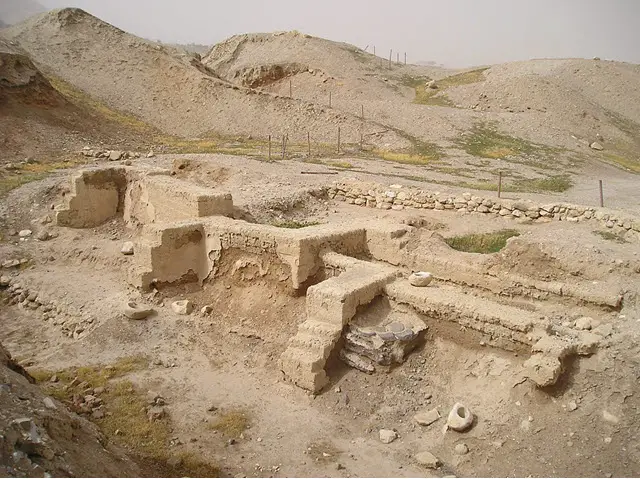
The es-Sultan or Tel Jericho site is the lowest and the oldest town ever existing on Earth. It is also associated with ancient Jericho and often cited in biblical and historical sources.
The site is supported by an inexhaustible spring of Ein es-Sultan, fertile alluvial soil, and tropical climate, making it all the more suitable for the Neolithic and Natufian people to inhabit.
The site underwent a multitude of excavations and rehabilitations, which yielded many artifacts attesting to the presence of Natufians.
The consecutive excavations have led to testimonies that span over 10,000 years, including the Neolithic and Natufian remains. The former is represented by roundhouses of mud-brick with a round tower, suggestive of the fortification system’s earliest period.
It is also known as the Pre-Pottery Neolithic A phase or PPNA, followed by the later phase called Pre Pottery Neolithic B (PPNB), characteristic of rectangular houses made of long bricks. Below the floors of these houses lay plastered skulls that indicate an ancestral cult practiced at that period.
The site was also where the transformation from hunter-gatherers into agricultural farmers materialized. The Neolithic period saw a transition from hunting and locomoting to subsistence farming and settlement in Tel es-Sultan’s site.
9. Sha’ar HaGolan (Israel)

Sha’ar HaGolan is a main Neolithic archaeological site in Israel, where a significant number of art objects and pottery were excavated. Located in the central Jordan Valley and north of the Yarmouk river, it was the largest (20 hectares) settlement area of the period.
The Sha’ar HaGolan underwent a series of excavations, which produced courtyard houses in the second attempt. These findings contribute highly to the architectural significance of the Neolithic period. It is an architectural concept dominating traditional Mediterranean societies.
The houses consisted of many small rooms interconnected to a central courtyard. Among the houses ran pavements, topped with many pebbles in mud, about 3 meters wide. The inhabitants had made ample use of locally available materials in constructing the houses and the streets.
The findings of streets in Sha’ar HoGolan are recognized as the earliest streets built by humankind. In addition to that, the whole architecture of houses and courtyards, led by streets, illustrates immaculate, even advanced community planning.
Other findings such as a well dug as deep as 4.5 meters suggest the hydraulics of the Neolithic people. Besides, there lay seashells from the Mediterranean, stone vessels of marble, obsidian of Turkey chiseled into blades that established the connection of trade spanning more than 700km.
8. Nevali Cori (Turkey)

Nevali Cori was a Neolithic settlement area housing archaeological remnants from the Neolithic period. It is known to have housed some of the world’s oldest temples, monumental sculptures, and a tame wheat type called Einkorn.
The presence of flint tools suggests the early PPNB settlements, and there are plenty of archaeological shreds of evidence of houses from the early Neolithic period. The rectangular houses were made of elongated bricks with parallel rooms.
They were attached to a similar rectangular structure, divided by walls, purportedly for residence. This superstructure was laid first with boulders placed end to end, and any gaps among them were covered by tiny pebbles to even the surface.
At the interval of every 1-1.5 meter of such foundations lay stone slabs with openings at both ends, placed at 90 degrees to the houses’ main axis. The purpose being drainage and aeration or cooling of the houses. It indicates that the inhabitants of that period were adept in planned settlements.
The examination of the site produced 23 of such superstructures at Nevali Cori. A little further North of the village possesses special importance for it boasts a lime cement floor. It is suggestive of the pyro technology, which was another debut technology advanced by the Neolithic people. The interiors contained twin pillars of about 3 meters in height, another architectural brilliance of that period.
7. Skara Brae (Scotland)
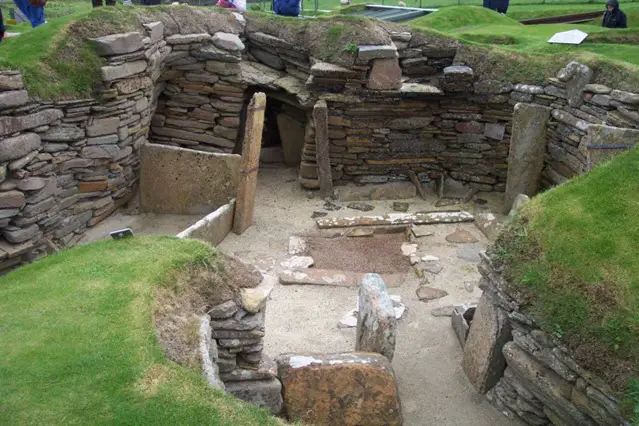
Skara Brae is an all-stone built Neolithic settlement located on the largest island of the Orkney archipelago of Scotland. It is older than the Great Pyramids of Giza and the Stonehenge and has been deservingly called the ‘Scottish Pompeii’ for such brilliant preservation.
Upon examination, the archaeologists found ten of clusters of houses made of flagstones. They consisted of earthen dams supporting the walls, while the inside of the houses had beds, cupboards, and stone hearths for heating and cooking. A primitive sewer system and toilet and drainage assisted it in carrying the effluents to the ocean.
The houses’ architecture was mostly Earth sheltering, which protected them from the biting cold of Orkney and provided stability. In each of the houses was a cupboard, dresser, storage boxes, seats, and stone hearths.
Although what kept the hearth burning is still unknown, researchers suggest it be peat or driftwoods, or dried seaweed.
The dwellings consisted of two stone beddings, one bigger and one smaller. The former is suggested to be of a male and the latter of a wife. The presence of beads and painted pots help in interpreting this.
The dwellers were known as the grooved ware people for their extensive use and grooved ware, a style of pottery.
6. Gobekli Tepe (Anatolia, Turkey)

Gobekli Tepe is also known as Gire Mirazan or Xirabreske. It is a large archaeological site located in the Anatolia of Turkey. It witnessed the rise and fall of two phases: the PPNA and the PPNB purported for social and ritual use.
During the first phase of PPNA, huge T-shaped stone pillars encircled the site. They are known as the world’s oldest megaliths, dating to around 9,500 BC. They are older than Mesopotamia by 5,500 years and Stonehenge by 7,000 years.
The geophysical surveys show more than 200 pillars in about 20 circles at the site. Each pillar is weighing 10 tons and with a height of about 20 feet. Each of them clasped into sockets made from the surrounding bedrock.
The second phase of the PPNB shows smaller pillars erecting the rectangular rooms of polished lime floors. These rooms and pillars’ functions continue to remain a mystery despite multiple excavations at Gobekli Tepe. What we know is that it is a UNESCO World Heritage Site.
The site is located on a flat plateau, following a geometric pattern. All three complexes-A, B, and C form an equilateral triangle. It testifies the rudimentary knowledge of the geometry of the inhabitants and their advancement in astrology even.
5. Ggantija (Malta)
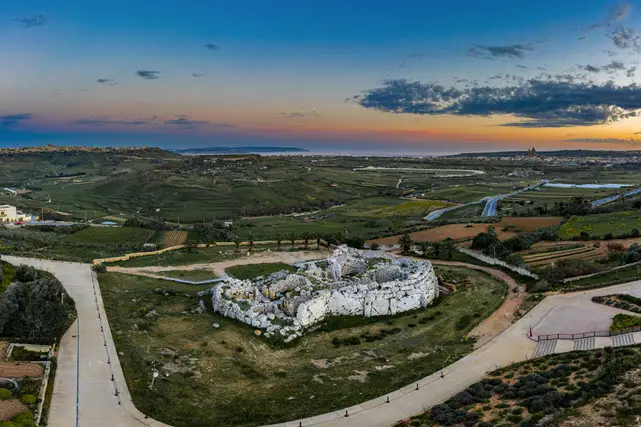
Ggantija temple is over 5,500 years old and is the second oldest human-made structure after Gobekli Tepe. It is a large monolithic temple of the Neolithic period, located in Malta, and is older than the Pyramids.
The temples are essentially ceremonial components of a fertility rite performed at the site. Folklore speculates that a giantess constructed these temples with a child on her shoulders as a place of worship.
The site comprises two temples and a third one which is yet to complete. The temples form the shape of a cloverleaf, and the gaps remaining are closed with rubble. They also boast large apses containing various altars. The bones found at the site link to animal sacrifice.
It is truly marvelous to behold the monuments and wonder how much trouble it took to build the temples, especially when there were no wheels to transport the rocks. However, the site featured small spherical stones used as ball bearings.
The temples bear far more religious and astronomical significance. For one, it faces the southeast, and the entrance is laden with a huge stone with recess. It is assumed that it was a place for religious ablution.
4. Knowth (Ireland)
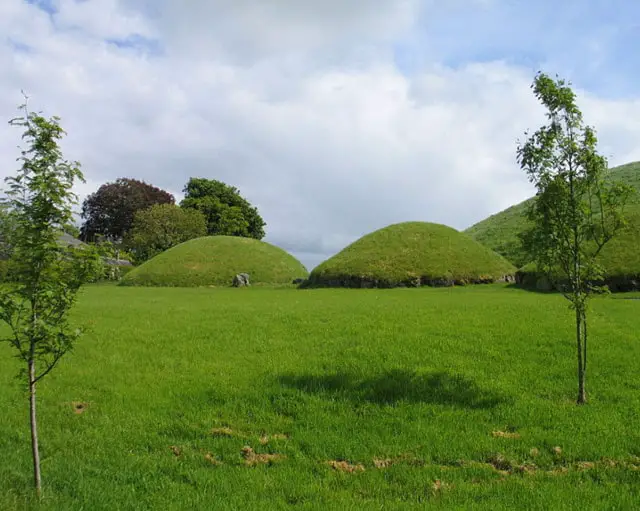
Knowth is a large Neolithic burial site or passage grave, listed as a World Heritage Site. As the largest passage grave of the Bruna Boinne complex, it consists of a big mound called Site 1 and about 17 other smaller mounds.
The passages independently lead to the burial sites, where the eastern passage leads to a cruciform chamber and the western to an undifferentiated chamber. The right-hand recess is ornately designed with megalithic art, which is similar to common Irish passageways.
Much of the monolithic artworks are found on the kerbstones on the entrance to the passageways. Knowth alone accounts for a quarter of the total number of monolithic art in Western Europe with over 200 decorated stones.
Spirals, lozenges, and serpentiform were the most common motifs found etched on the stones. Besides these, the crescent moon was found plentiful on the back of the stones. It was the earliest etched artwork of the moon known to date. They also contained a lunar map and a sundial.
The grooved ware timber circle in front of the eastern passage testifies to some late Neolithic activities there. Archaeological evidence, such as the votive offerings, points to it as a ritual or sacred place.
It is amusing to learn that the underground east-west passage is aligned with the equinoxes. How the site was designed remains a mystery to us, just as to why they were engraved on stones. However, we do know if it was a ceremonial necropolis.
3. Newgrange (Ireland)
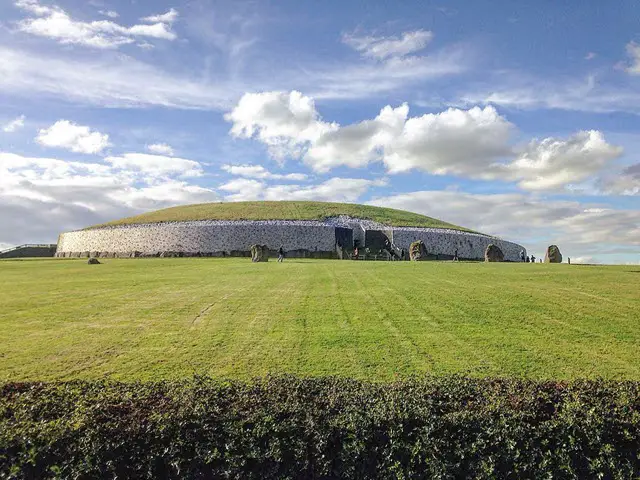
Located in the Boyne Valley of Ireland, Newgrange is a 5,200-year-old passage tomb built by the Stone Age farmers or Neolithic Period. The mound stands tall and proud in an area of 1 acre with about 13 meters of height and 85-meter diameter.
A passage of 19 meters leads to the chamber with three alcoves. It is aligned with the chamber so that they both illuminate with the rising sun in the winter solstice. Newgrange is encircled by 97 engraved monoliths called kerbstones. Among them, the most fascinating is the one on the entrance with symbols and hidden meanings.
It was constructed about 5,200 years ago (3,200 BC), which makes it older than Stonehenge and Giza’s Pyramids. It is known as the jewel in the crown of Ireland’s Ancient East and has been listed under UNESCO’s World Heritage Site.
A passage tomb is an understatement for this colossal house of architectural, religious, symbolic, ceremonial, and astronomical significance. Hence, the Ancient Temple has been aptly termed Newgrange.
The mound takes the shape of a large kidney and is enriched with megalithic art. A corbelled roof accompanies the inner passage leading to the cruciform chamber.
The techniques and architecture suggest that those people invested much of both time and labour in its construction. It is living proof of the organized society and specialized groups of people of the then era.
The dramatic illumination of the passage and chambers every winter solstice sun should be the fascinating thing of Newgrange. It lasts for about 17 minutes, which remarkably place Newgrange as the most accurate time-telling device of that time.
2. Avebury (England)
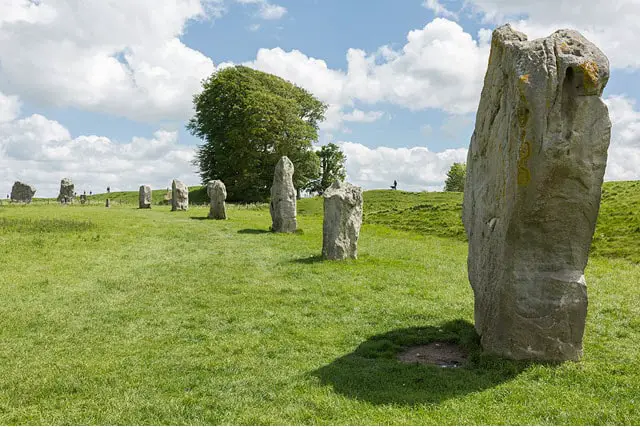
Constructed in the Third Millennium BC or the New Stone Age (Neolithic period), Avebury holds the largest megalithic stone circle in the world. This henge monument comprises three stone circles covering the village of Avebury in Southwest England.
The monument contains a large stone circle, two small separate inner stone circles, and in the middle lies a giant stone henge with a bank and a ditch. Archaeologists suggest a site used for some form of ritual or ceremony, although the original purpose is still unknown.
There is also various evidence of Neolithic activity around the vicinity of the henge. Animal bones and flintstones are some of the key findings scattered around the site. As many as five different areas of evidence of their activity have been identified within 500 meters from the site.
The construction of large monuments, when dated, produced different periods. Archaeologists have suggested differing periods for each of the large, small, and medium stones.
The henge is also associated with long barrows, enclosures, passageways, chambers, stone circles, and avenues.
The stones erected on the Earth also have varying sizes and structures. Some of them are short and flatter, while others are lean and tall. These stones have been attributed to the genders of females and males, respectively.
The Sanctuary, the Silbury Hill, and West Kennet Long Barrow also housed the henge structures. It is assumed that these henges were intentionally and carefully juxta positioned around Britain’s villages to show their movement and connections. However, the purpose is uncertain.
1. Stonehenge (Salisbury Plane, England)

Stonehenge, the ring of large stones, is a famous archaeological site. Neolithic, Bronze Age surrounds it, and Iron Age remains. It was first built around 3000BC, while the second phase is dated around 2580 BC.
It used to be a cemetery during the Third Millenium. The stones are a combination of sarsen stone and so-called ‘bluestones’ from the Preseli region of Wales 220km to the west. However, the age of Stonehenge is controversial and uncertain.
It aligns with the solstice and so may have cosmological associations. It may also have been built as a symbol of “peace and unity.” At the time, Britain’s Neolithic people were experiencing a period of cultural unification.
Stonehenge was a cemetery consisting of 240 cremations buried over 600 years (63 recorded cremations and over 40 unburnt human bones). It is, therefore, the biggest cemetery in Britain (but could be a small dynasty).
The purpose and the modus of the construction of Stonehenge remain a subject of debate. Similarly, the tall trilithons of a horseshoe arrangement are shrouded with myths.
Special astronomical importance and other associations are equally debatable. It is of view that the central stone structures embodied far more symbolic meanings rather than merely a single purpose.
A square-in-circle motif could represent a sacred house or a big house edged by five Sarsen Trilithons. Initially arranged as a twin circle, these stones were rearranged many times over the following centuries.
The trilithon, the heel stone, and the avenue are made to align with the sunset of the winter solstice and oppose the sunset of the summer solstice. Excavations at the site surfaced animal bones that suggest that people may have gathered there during the winter.
Association with water and healing is why this Sarsen architecture holds a significant place in prehistoric times.
Conclusion
People in the Neolithic period built the monoliths-giant monuments with religious and social importance. In the era, the monoliths aligned with the celestial bodies’ astronomic events, indicating people’s advanced understanding of complex star-charts and astronomical theories.
Their architecture is an amalgamation of minimalism and sophistication. The people engineered proficiently in boulders with mathematical precision.
They were also creative and quick to resolve issues that arrived at architecting houses, passage graves, dolmens, and monoliths.
Their art and architecture serve as a large reservoir of debunked mystery and hidden meanings that we are yet to uncover. All in all, they were the builders of simple structures with a multitude of underlying meanings.
